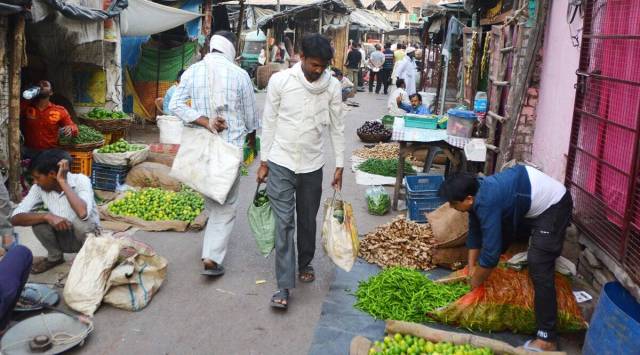Factory output uptick 4.2% in April, inflation cools to 4.25% in May
Manufacturing, which has more than three-fourths (77.6 per cent) weight in IIP, increased 4.9 per cent in April as against 5.6 per cent in the year-ago period and 1.2 per cent in March.
 The retail inflation remained within the tolerance range of the RBI for the third consecutive month. (File image)
The retail inflation remained within the tolerance range of the RBI for the third consecutive month. (File image) FACTORY output grew at a higher-than-expected clip of 4.2 per cent in April, primarily driven by a low base effect and a pick-up in manufacturing and mining sectors, data released by National Statistical Office (NSO) Monday showed. Separately, data released on consumer price index inflation showed retail inflation slipping to a 25-month low of 4.25 per cent in May on the back of easing food prices.
In absolute terms, the Index of Industrial Production (IIP) increased to 140.2 in April from 134.5 in the year-ago period but was sequentially lower than 151.4 seen in March this year. Manufacturing, which has more than three-fourths (77.6 per cent) weight in IIP, increased 4.9 per cent in April as against 5.6 per cent in the year-ago period and 1.2 per cent in March.
Experts said manufacturing growth in April firmed up from a five-month low in March due to base effect, and sectors such as capital goods (6.2 per cent) and infrastructure/ construction goods (12.8 per cent) showed good growth on the back of a push for capital expenditure by the government. Going ahead, it remains to be seen if this recovery will sustain amidst a global slowdown and its impact on external demand.
“In sequential terms, (manufacturing) output contracted 5.4% month-on-month… textiles, wearing apparel, leather and computer and electronics output remained in the red — extending a trend evident since December 2022. These products historically have had high sensitivity to external demand, and hence are seeing relatively sharper declines than other sectors…the services sector is expected to anchor growth in the current fiscal year, with manufacturing output expected to remain weak owing to headwinds from a global growth slowdown. Some support to manufacturing may come from still resilient domestic demand, and to an extent, the build-out of manufacturing capacity (for example, for smartphones),” Rahul Bajoria, MD & Head of EM Asia (ex-China) Economics, Barclays, said.

While consumer durables output, which indicates consumption demand, continued to contract for the fifth consecutive month at (-)3.5 per cent in April as against 7.2 per cent growth in the year-ago period, consumer non-durables picked up pace in April. Consumer non-durables, which is an indicator for fast-moving consumer goods, grew 10.7 per cent in April as against (-)0.8 per cent contraction in the year-ago period. The impact of unseasonal rains was also visible in the electricity output, which recorded a contraction of 1.1 per cent in April.
“FMCG has been a surprise with 10.7% growth due to base effect and we may have to wait for a couple of more data points to draw firm conclusions on a recovery. Consumer durables registered negative growth which is surprising given that this is the post-rabi harvest season when demand typically picks up…We need to wait and watch on the sustainability of these numbers to feel reassured about growth. But such numbers will provide additional tools for taking monetary policy decisions as it does look like that growth is not being hampered…we need to wait and watch the sustainability of these numbers to feel reassured about growth. But such numbers will provide additional tools for taking monetary policy decisions as it does look like that growth is not being hampered,” Madan Sabnavis, Chief Economist, Bank of Baroda said.
Retail inflation marked the sub-5 per cent print for the second consecutive month in May and marked the fourth month of an easing trend in inflation. The previous low for inflation was 4.23 per cent in April 2021. While combined food price inflation eased to 2.91 per cent in May from 3.84 per cent in April, inflation in fuel and light eased to 4.64 per cent from 5.52 per cent in April.
Experts expect an extended pause by the Reserve Bank of India on its policy rate stance in the upcoming monetary policy meetings. However, cereals and milk inflation rates remained high in May. “The worrying trends in May 2023 inflation are: a) cereals inflation although has reduced from its recent peak of 16.73% in February 2023 has remained in double digits in the last nine months, b) milk inflation remaining in excess of 6% in last 10 months, and c) core inflation remaining more than 5.0% in last 37 months,” Sunil Sinha, Principal Economist, India Ratings and Research said.
The central bank, however, is expected to keep its guard up for core inflation — the non-food, non-fuel segment of the inflation rate, and the impact of El Nino on food prices in the coming months. “Going forward, inflation is expected to remain in the 4.4%-5.4% range for the rest of this fiscal. India Ratings expects RBI to maintain a pause on the interest rate for the rest of FY24,” Sinha said.



- 01
- 02
- 03
- 04
- 05



























